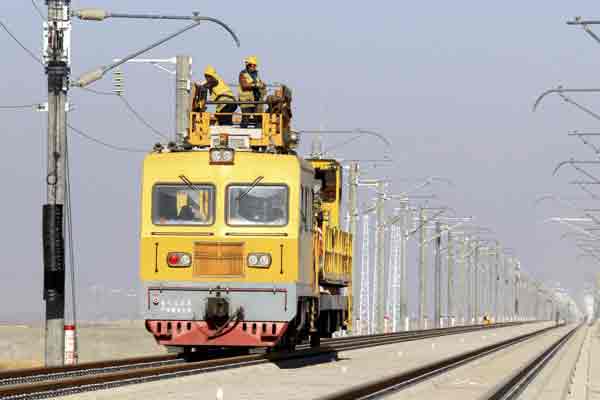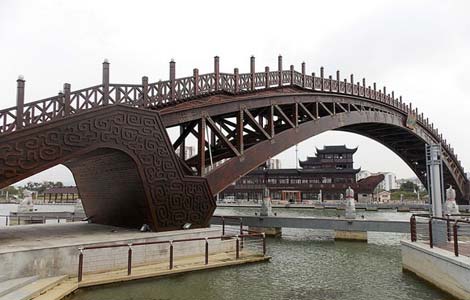

|
 The Hami section of Lanxin Railway is being electrified in this photo taken on October 21, 2013. [Photo/Xinhua] |
URUMQI - For northwest China's Xinjiang Uygur autonomous region, a new high-speed rail line means more than just easier access for travelers and tourists.
Officials and industry observers hope the Second Double-track Line of the Lanxin Railway, which links Lanzhou City in northwestern Gansu Province and Urumqi, the regional capital of Xinjiang, will bring an economic boom to the region.
The 1,776-km line crosses a vast expanse of the Gobi Desert and windy areas -- a major technical feat -- and will be Xinjiang's first high-speed railway when it begins operation in 2014. Track laying for the line was completed on November 16.
China has built the world's longest and most heavily used high-speed railway network -- nearly 10,000 kilometers -- and the new line is expected to incorporate Xinjiang, which accounts for one sixth of China's land area, into the existing network in the eastern and central parts of the country.
"The high-speed trains will make passenger travel easier between Xinjiang and other parts of China, but more importantly, it will unleash the region's transportation capacity," said Zhang Yongheng, a publicity official with the Urumqi Railway Bureau.
The Lanxin Railway is currently the only railway connecting Xinjiang with other provincial regions. The new line takes a slightly different route, winding into neighboring Qinghai Province before re-entering Gansu and picking up the old route that heads northwest toward Xinjiang.
With trains designed to run at a minimum speed of 200 km per hour, the rail line will slash the travel time between Lanzhou and Urumqi from the current 21 hours to 8 hours or less.
As more passengers opt for the faster bullet trains, the old Lanxin Railway will focus on freight transport and more than double its current freight capacity, according to Zhang.
Railways have so far constituted only a small segment of Xinjiang's transportation. In 2011, 10.4 percent of the region's goods were delivered via railway, compared with 84.1 percent via highways, said Zhao Changmao, economics professor at the Party School of the Communist Party of China Central Committee.
However, trains are a more efficient means of transportation for Xinjiang's profusion of minerals and agricultural products such as cotton and fruit, especially considering the vastness of the region, industry observers said.
Zhao said the new high-speed railway will benefit the development of modern logistics in Xinjiang, which will be an important boost to the economy in the region and northwest China as a whole.
Xinjiang sits along the ancient Silk Road and the modern Eurasian Land Bridge, a transcontinental rail route. It is often considered a bridgehead for China's economic and trade ties with central Asian countries.
However, laying rail tracks in the region has long been a technical conundrum. The arid and unpopulated environment along the high-speed line has created complexities in its construction, and workers have had to build about 440 km of walls or "screens" to protect the trains from the area's devastating gales, according to Zhang.
 Largest span timber arch bridge
Largest span timber arch bridge
 Porsche 911 Turbo S Asian premiere fascinates Auto Guangzhou
Porsche 911 Turbo S Asian premiere fascinates Auto Guangzhou
 Auto Guangzhou witnesses new Porsche sports cars Asia Premiere
Auto Guangzhou witnesses new Porsche sports cars Asia Premiere
 2013 Guangzhou auto show carmakers' eventers
2013 Guangzhou auto show carmakers' eventers
 Models at Volvo pavilion at 2013 Guangzhou auto show
Models at Volvo pavilion at 2013 Guangzhou auto show
 Lexus new hybrid hatch CT200h world premiere in Guangzhou
Lexus new hybrid hatch CT200h world premiere in Guangzhou
 New C-X17 showcases Jaguar's crossover concept
New C-X17 showcases Jaguar's crossover concept
 Acura all-new 2014 MDX comes to China
Acura all-new 2014 MDX comes to China